Binturongs are medium sized mammals, which are also known as the “bearcat,” or the “Asian bearcat,” because they look like a cross between a bear and a cat. However, they are not related to either bears or cats; they are a civet. Binturongs live high in the trees of forests in South-East Asia. Read on to learn about the binturong.
Description of the Binturong
Binturongs have long, heavy bodies, and short, stocky legs. They have short, pointed snouts that contain more teeth than most carnivores. They also have many thick, conspicuous white whiskers. Their coats are long, coarse, and shaggy, which helps keep them dry. The main area of the coat is dark brown to black in color, but it is tipped with gray.
Their faces are usually a paler color. Binturongs have long ear tufts on small, rounded ears, and reddish-brown eyes that give them rather an attractive appearance. Females are about 20 percent larger and heavier than males, making this a sexually dimorphic species.
Interesting Facts About the Binturong
Binturongs have adapted to a life spent almost entirely in the trees, and for eating a wide variety of foods. They also have several other adaptations which means there are several interesting facts about Binturongs.
- Prehensile Tail – The binturong is one of only two mammals that have prehensile (gripping) tails. The tail has a leathery patch at the end to help grip branches.
- Flexible Wrists – Binturongs can rotate their wrists 180º so they can grip when climbing head-first down trees.
- Delayed Implantation – Binturongs are one of the few mammals that reproduce by delayed implantation. Although mating occurs at any time of the year, the fertilized egg doesn’t immediately implant in the female’s uterus, but instead, lingers in her body until she is in a suitable condition for birth.
- Characteristic Smell – Binturongs have a characteristic smell – to humans, they smell like hot, buttered popcorn.
Habitat of the Binturong
Binturongs live in the canopies of tall, dense, tropical forests. They require thick vegetation, both in the trees and on the ground.
Distribution of the Binturong
Binturongs live throughout South-East Asia, but populations are dwindling drastically in many areas.
Diet of the Binturong
Although binturongs are classified as carnivorous, they mainly eat fruit. They supplement this by hunting and eating small mammals, birds, insects, fish, and eggs.
Binturong and Human Interaction
Binturongs are sometimes hunted for their meat, skin, and the pet trade; they also have body parts that are used in the Chinese medicine market. They are threatened by habitat loss, mainly due to deforestation for agriculture, particularly in the southern parts of the binturongs’ natural distribution, and increases in human settlement.
Domestication
Although they have frequently been kept as pets, they have not been domesticated.
Does the Animal Make a Good Pet
Binturongs have been widely kept as pets, particularly in Malaysia, but this has contributed to their decreasing numbers. They are occasionally ill-tempered and aggressive, which makes them difficult to keep as pets.
Binturong Care
The care requirements of binturongs are complex, and are better handled by experienced wildlife handlers and zookeepers.
Behavior of the Binturong
Binturongs are “arboreal,” which means they live in trees. They spend most of their time slowly and cautiously moving about in the trees, however, they are not very agile. So, rather than jumping or leaping between branches, they usually come to the ground to move between trees. When they walk, their gait is like a flat-footed amble. They are generally nocturnal, but sometimes search for food during the day.
When resting or sleeping, binturongs wrap their tails around the branch to secure themselves. If they are hunting prey in the trees, they do this using behavior very much like a cat. They are good at swimming and diving, so they also hunt fish.
Binturongs mark their territory with scent glands under the tail. It is the odor from these glands that gives them an odor that reminds humans of hot, buttered popcorn. They also advertise their presence with vocalizations, such as howls, grunts, and hisses.
Reproduction of the Binturong
Binturongs are one of the few mammals that can reproduce using delayed implantation. Both males and females become sexually mature at approximately 30 months (2.5 years) of age. Females will indicate to males that they are ready for mating by purring. After a pregnancy of approximately 3 months, the female gives birth, usually to 1 – 3 offspring, although as many as 6 have been recorded.
Binturong babies are born with their eyes closed. They hide in the mother’s thick fur for their first few days, but are weaned by 6 – 8 weeks of age, when they are the size of a domestic cat, and have grown a coat of their typically coarse hair. At this age, they begin to explore their environment and eat solid food.


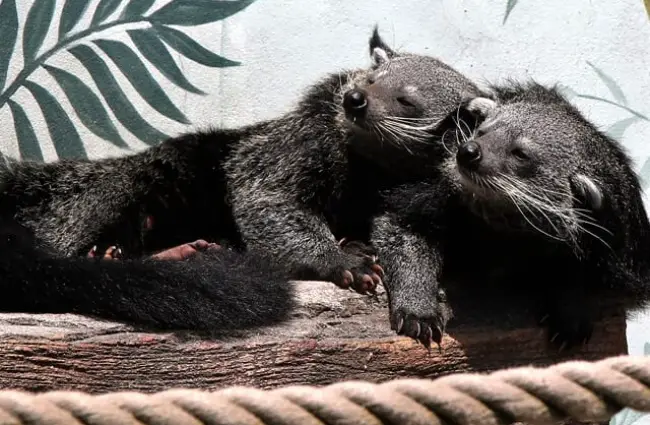
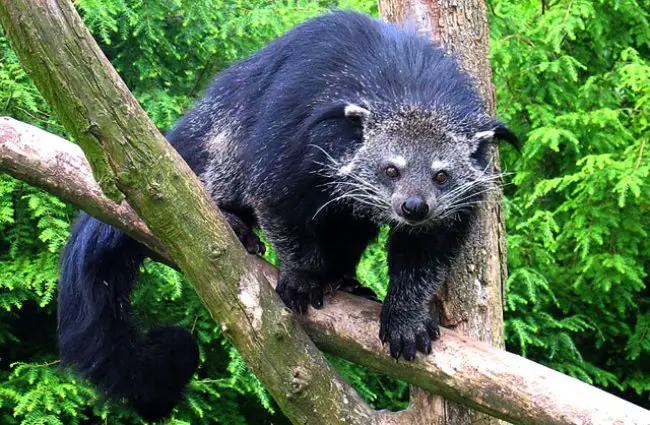

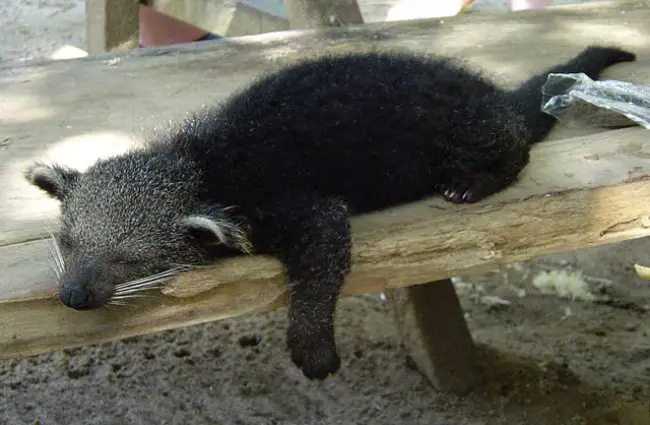
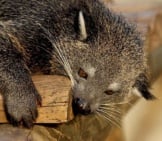

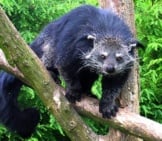
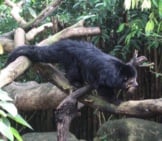
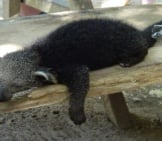
![Red Angus Closeup of a beautiful Red Angus cowPhoto by: U.S. Department of Agriculture [pubic domain]https://creativecommons.org/licenses/by/2.0/](https://animals.net/wp-content/uploads/2020/03/Red-Angus-4-238x178.jpg)


![Red Angus Closeup of a beautiful Red Angus cowPhoto by: U.S. Department of Agriculture [pubic domain]https://creativecommons.org/licenses/by/2.0/](https://animals.net/wp-content/uploads/2020/03/Red-Angus-4-100x75.jpg)

